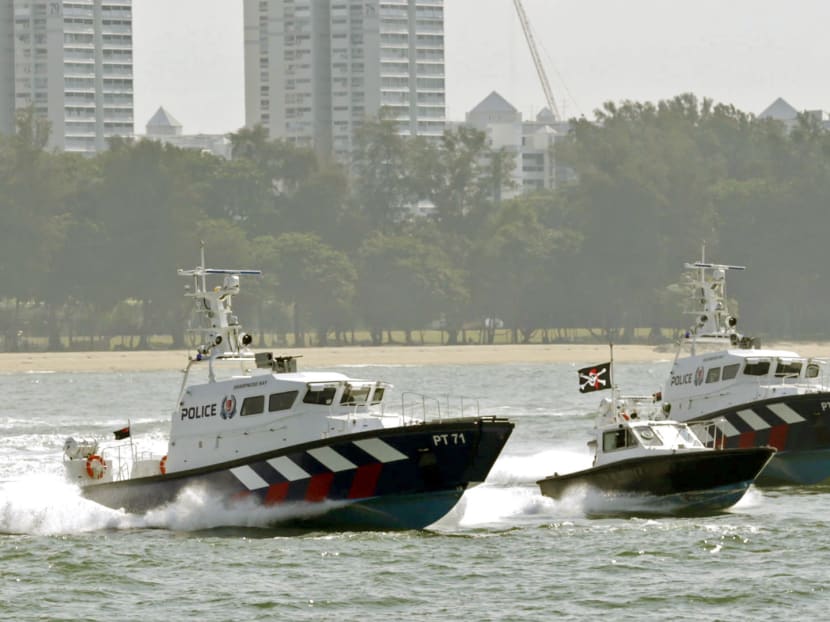More cameras, vessels to help police nab intruders at sea
SINGAPORE — The number of electro-optic cameras deployed across Singapore to keep out intruders at sea will be nearly doubled, as illegal immigrants and smugglers are resorting to sneakier schemes to give marine police the runaround.

Patrol Interdiction Boats on display at East Coast Park on July 21, 2015. The boats can reach speeds exceeding 80kmh. Photo: Wee Teck Hian
SINGAPORE — The number of electro-optic cameras deployed across Singapore to keep out intruders at sea will be nearly doubled, as illegal immigrants and smugglers are resorting to sneakier schemes to give marine police the runaround.
The beefing up of the Police Coast Guard’s (PCG) surveillance capabilities with these high-powered cameras was announced by Deputy Prime Minister and Home Affairs Minister Teo Chee Hean today (July 21) at the commissioning ceremony of new patrol and interception vessels.
Referring to how sophisticated illegal immigrants and smugglers have become in their activities, Mr Teo said: “They now employ decoys and camouflage, conduct reconnaissance, and use faster boats that attempt to breach our maritime defence or make dangerous manoeuvres to evade arrest.”
Nevertheless, the PCG managed to arrest 46 illegal immigrants attempting to enter by sea, and prevented more than 7,000 suspicious vessels from intruding into Singapore’s waters last year.
The new vessels PCG will be adding to its arsenal by February next year boosts its ability to chase down and cut out targets, Mr Teo noted.
The 11 Patrol Interdiction Boats, for instance, can reach speeds exceeding 45 knots (80kmh) and come with armour protection. They are outfitted with Stablised Naval Gun Systems, which can track targets automatically and are more accurate. They also have beaching capabilities, allowing officers to dismount onto land quickly to continue pursuit if their target gets to shore.
The six 2nd Generation PK Class High Speed Interceptor, which are even more powerful, will be used by the marine police’s elite squadron to deal with “aggressive, fast-moving sea-borne threats”, said Mr Teo. They have improved manoeuvrability and speeds in excess of 55 knots (100kmh), versus the top speeds of 45 knots for current boats.
“Together with our current fleet, these new boats will enable PCG to intercept and deal more decisively with intruding boats which are becoming faster and better equipped, before the intruding boats reach our shores,” he added. The Patrol Interdiction Boat commissioned yesterday was named “Atlantic Ray”, while the 2nd Generation PK Class High Speed Interceptor was named “White Marlin”.
In addition, the PCG Command, Control and Communications system will also be progressively upgraded to improve coordination between PCG’s Operations Centre and its sea and land resources, to detect and intercept intruding boats more quickly.
In terms of deterrence, Mr Teo had previously said that an additional 80km of land- and sea-based barriers will be put up along the shoreline to deter illegal landings. This is more than double the current length of such barriers (63km).
Mr Teo also stressed that the security threats to Singapore’s maritime environment are becoming increasingly complex, with tankers in the nearby Straits of Malacca and US naval warships berthed in ports in the region mentioned as targets in Al-Qaeda’s call last October to disrupt global trade and shipping through acts of piracy, among other tactics.
He noted that the distance between international boundaries and the Singapore shoreline is as short as less than 500m in some places. “This gives us little reaction time and space to respond to any sea-borne threats before it reaches our shoreline – which could be less than a minute for a boat travelling at high speed,” he said.
“Our maritime security depends on the constant vigilance and efforts of our ground units and officers ... Working closely together, the PCG and Singapore’s maritime agencies strengthen our ability to safeguard our waters and sea borders for the benefit of Singaporeans and the international shipping community,” he added.






